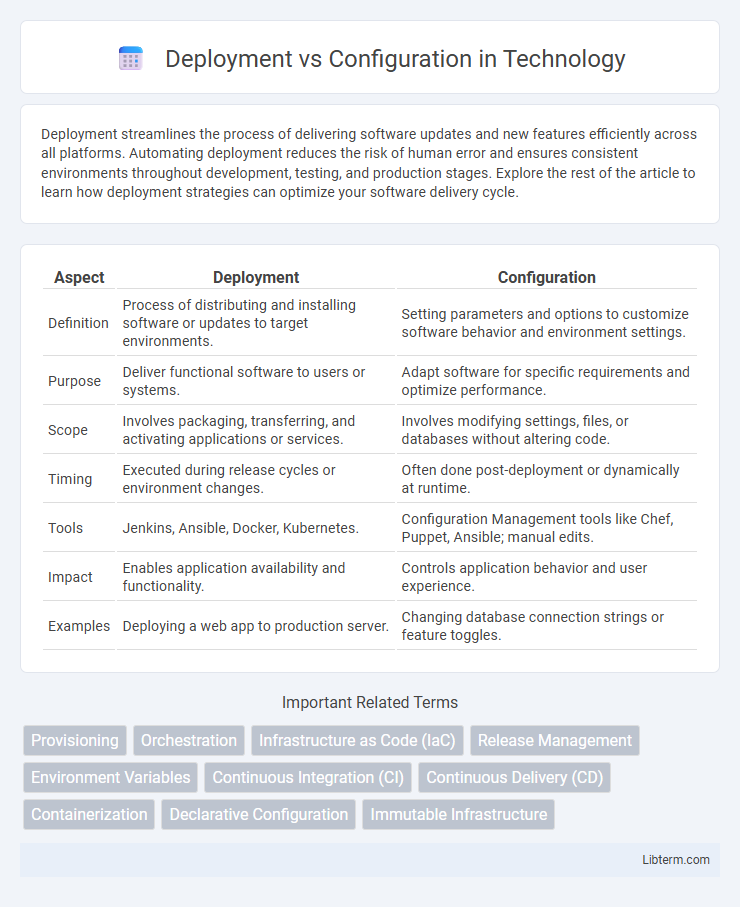Deployment streamlines the process of delivering software updates and new features efficiently across all platforms. Automating deployment reduces the risk of human error and ensures consistent environments throughout development, testing, and production stages. Explore the rest of the article to learn how deployment strategies can optimize your software delivery cycle.
Table of Comparison
| Aspect | Deployment | Configuration |
|---|---|---|
| Definition | Process of distributing and installing software or updates to target environments. | Setting parameters and options to customize software behavior and environment settings. |
| Purpose | Deliver functional software to users or systems. | Adapt software for specific requirements and optimize performance. |
| Scope | Involves packaging, transferring, and activating applications or services. | Involves modifying settings, files, or databases without altering code. |
| Timing | Executed during release cycles or environment changes. | Often done post-deployment or dynamically at runtime. |
| Tools | Jenkins, Ansible, Docker, Kubernetes. | Configuration Management tools like Chef, Puppet, Ansible; manual edits. |
| Impact | Enables application availability and functionality. | Controls application behavior and user experience. |
| Examples | Deploying a web app to production server. | Changing database connection strings or feature toggles. |
Understanding Deployment and Configuration
Deployment involves the process of distributing and installing software or applications to target environments, ensuring that all necessary components are correctly placed and operational. Configuration refers to setting parameters and options within the deployed system to tailor functionality, performance, and security according to specific requirements. Understanding the distinction between deployment and configuration is critical for efficient system management, as deployment ensures availability while configuration customizes the behavior of software in production environments.
Key Differences Between Deployment and Configuration
Deployment involves the process of delivering and installing software or applications onto a target environment, ensuring they are operational and accessible to users. Configuration refers to setting and adjusting software parameters or system options to customize functionality and performance according to specific requirements. Key differences include deployment being a one-time or periodic activity related to release management, while configuration is continuous and adaptable to dynamic system needs without changing the core software.
The Role of Deployment in Software Lifecycle
Deployment plays a critical role in the software lifecycle by delivering the final product to end-users through processes like installation, testing, and release management. It transforms developed code into a functional system within the target environment, ensuring operational readiness and user accessibility. Effective deployment strategies minimize downtime and performance issues, directly impacting software reliability and user satisfaction.
Configuration: Purpose and Importance
Configuration involves setting parameters and options to tailor software or systems for specific environments, ensuring optimal performance and functionality. Proper configuration enables seamless integration with other components, enhances security by enforcing policies, and supports scalability to meet evolving demands. Its importance lies in preventing errors, reducing downtime, and enabling efficient management across diverse infrastructure and applications.
Deployment Processes and Best Practices
Deployment processes involve systematically moving software from development to production environments, ensuring reliability and minimizing downtime. Best practices emphasize automated continuous integration and continuous deployment (CI/CD) pipelines, comprehensive testing stages, rollback strategies, and environment consistency through containerization or infrastructure as code. Effective deployment also requires clear version control, monitoring solutions, and collaboration between development, operations, and QA teams to achieve seamless releases and quick issue resolution.
Configuration Management Tools and Techniques
Configuration management tools such as Ansible, Puppet, and Chef automate the process of maintaining system settings, ensuring consistency across environments by defining infrastructure as code. These tools enable version control, automated updates, and rollback capabilities, reducing errors and enhancing scalability compared to manual configuration approaches. Proper configuration management techniques improve system reliability and facilitate compliance with security policies by enforcing standardized configurations across multiple servers.
Impact of Deployment on System Performance
Deployment directly affects system performance by determining how software components are distributed across hardware resources, influencing latency, throughput, and resource utilization. Optimal deployment strategies ensure balanced loads, reduce bottlenecks, and enhance responsiveness, while poor deployment can lead to inefficient CPU and memory use, causing slowdowns and system instability. Monitoring deployment impact with performance metrics such as response time and system availability is crucial for maintaining high-performance applications.
Configuring for Scalability and Reliability
Configuring systems for scalability involves optimizing resource allocation and load balancing to handle increased traffic without performance degradation. Reliability is enhanced through automated failover mechanisms and redundant configurations ensuring continuous operation during failures. Effective deployment strategies integrate scalable configurations with continuous monitoring to promptly address bottlenecks and system faults.
Common Challenges in Deployment and Configuration
Common challenges in deployment include environment inconsistencies, which lead to code working locally but failing in production, and inadequate automation that causes manual errors and delays. Configuration issues often arise from mismanagement of environment variables and lack of centralized configuration control, resulting in improper settings that affect system behavior. Both deployment and configuration failures typically stem from poor version control and insufficient testing, complicating troubleshooting and increasing downtime.
Choosing the Right Approach for Your Project
Choosing the right approach between deployment and configuration is crucial for project success, as deployment focuses on delivering the complete application environment, while configuration customizes software settings to meet specific needs. Effective deployment ensures that the software operates in the intended production environment, minimizing runtime errors, whereas proper configuration enhances system performance and user experience by tailoring parameters such as database connections, API endpoints, and security settings. Evaluating project requirements, team expertise, and infrastructure complexity helps determine whether emphasizing deployment automation or dynamic configuration management is more beneficial for scalability and maintainability.
Deployment Infographic

 libterm.com
libterm.com